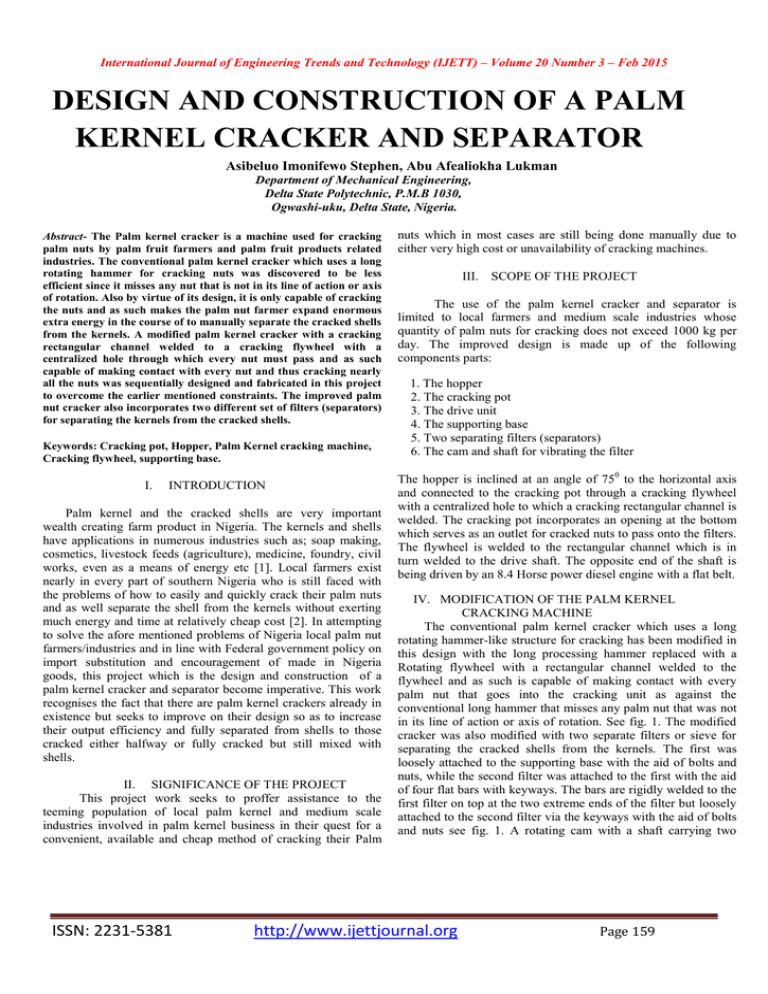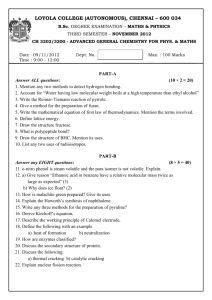DESIGN AND CONSTRUCTION OF A PALM KERNEL CRACKER AND SEPARATOR
advertisement

International Journal of Engineering Trends and Technology (IJETT) – Volume 20 Number 3 – Feb 2015 DESIGN AND CONSTRUCTION OF A PALM KERNEL CRACKER AND SEPARATOR Asibeluo Imonifewo Stephen, Abu Afealiokha Lukman Department of Mechanical Engineering, Delta State Polytechnic, P.M.B 1030, Ogwashi-uku, Delta State, Nigeria. Abstract- The Palm kernel cracker is a machine used for cracking palm nuts by palm fruit farmers and palm fruit products related industries. The conventional palm kernel cracker which uses a long rotating hammer for cracking nuts was discovered to be less efficient since it misses any nut that is not in its line of action or axis of rotation. Also by virtue of its design, it is only capable of cracking the nuts and as such makes the palm nut farmer expand enormous extra energy in the course of to manually separate the cracked shells from the kernels. A modified palm kernel cracker with a cracking rectangular channel welded to a cracking flywheel with a centralized hole through which every nut must pass and as such capable of making contact with every nut and thus cracking nearly all the nuts was sequentially designed and fabricated in this project to overcome the earlier mentioned constraints. The improved palm nut cracker also incorporates two different set of filters (separators) for separating the kernels from the cracked shells. Keywords: Cracking pot, Hopper, Palm Kernel cracking machine, Cracking flywheel, supporting base. I. INTRODUCTION Palm kernel and the cracked shells are very important wealth creating farm product in Nigeria. The kernels and shells have applications in numerous industries such as; soap making, cosmetics, livestock feeds (agriculture), medicine, foundry, civil works, even as a means of energy etc [1]. Local farmers exist nearly in every part of southern Nigeria who is still faced with the problems of how to easily and quickly crack their palm nuts and as well separate the shell from the kernels without exerting much energy and time at relatively cheap cost [2]. In attempting to solve the afore mentioned problems of Nigeria local palm nut farmers/industries and in line with Federal government policy on import substitution and encouragement of made in Nigeria goods, this project which is the design and construction of a palm kernel cracker and separator become imperative. This work recognises the fact that there are palm kernel crackers already in existence but seeks to improve on their design so as to increase their output efficiency and fully separated from shells to those cracked either halfway or fully cracked but still mixed with shells. II. SIGNIFICANCE OF THE PROJECT This project work seeks to proffer assistance to the teeming population of local palm kernel and medium scale industries involved in palm kernel business in their quest for a convenient, available and cheap method of cracking their Palm ISSN: 2231-5381 nuts which in most cases are still being done manually due to either very high cost or unavailability of cracking machines. III. SCOPE OF THE PROJECT The use of the palm kernel cracker and separator is limited to local farmers and medium scale industries whose quantity of palm nuts for cracking does not exceed 1000 kg per day. The improved design is made up of the following components parts: 1. The hopper 2. The cracking pot 3. The drive unit 4. The supporting base 5. Two separating filters (separators) 6. The cam and shaft for vibrating the filter The hopper is inclined at an angle of 750 to the horizontal axis and connected to the cracking pot through a cracking flywheel with a centralized hole to which a cracking rectangular channel is welded. The cracking pot incorporates an opening at the bottom which serves as an outlet for cracked nuts to pass onto the filters. The flywheel is welded to the rectangular channel which is in turn welded to the drive shaft. The opposite end of the shaft is being driven by an 8.4 Horse power diesel engine with a flat belt. IV. MODIFICATION OF THE PALM KERNEL CRACKING MACHINE The conventional palm kernel cracker which uses a long rotating hammer-like structure for cracking has been modified in this design with the long processing hammer replaced with a Rotating flywheel with a rectangular channel welded to the flywheel and as such is capable of making contact with every palm nut that goes into the cracking unit as against the conventional long hammer that misses any palm nut that was not in its line of action or axis of rotation. See fig. 1. The modified cracker was also modified with two separate filters or sieve for separating the cracked shells from the kernels. The first was loosely attached to the supporting base with the aid of bolts and nuts, while the second filter was attached to the first with the aid of four flat bars with keyways. The bars are rigidly welded to the first filter on top at the two extreme ends of the filter but loosely attached to the second filter via the keyways with the aid of bolts and nuts see fig. 1. A rotating cam with a shaft carrying two http://www.ijettjournal.org Page 159 International Journal of Engineering Trends and Technology (IJETT) – Volume 20 Number 3 – Feb 2015 bearings was also attached to the supporting base at the bearing casing points in a manner such that, the cam makes contact with the second filter, thereby vibrating it as it rotates while the second filter in turn vibrates the first filter which was loosely attached to it. The vibration action created does the filtration of kernels form cracked shells. It is worthy to note that, the cam is lubricated from time to time. at the bottom part of the cracking pot unto the first attached to the supporting base. The cracked kernels with average size of 11mm from observation and cracked shells with size less than 12mm falls through the first filter designed with holes of 12mm thereby retaining cracked shells with sizes bigger than 12mm as well as very few kernels bigger than 11mm. The second filter designed with holes of 10mm retain 90% of the kernels and filter off nearly all the cracked shells with size 10mm and less than 10mm that falls on it from the first filter. The kernels are removed or collected from the second filter while the cracked shells are removed from the first filter and underneath the second filter at regular intervals of 20 minutes so as to avoid blockage of the filter holes. VI. METHODOLOGY (FABRICATION PROCEDURES) The modified palm kernel cracker and separator are made up of the following main components; Hopper. Cracking pot. Drive unit. Supporting base. Two separate filters. Cam and shaft. Four flat bars for holding the two filters together. Springs. Descriptions of how these various parts were made with materials used are given below. A. Fabrication Of The Hopper The hopper is meant to receive the palm nuts before they are eventually moved into the cracking pot. It was made from a low carbon steel of 1.5mm thickness. See fig. 2a the low carbon steel sheet was marked out with the aid of set squares, steel rules, and scribers as shown in fig.2a. An allowance of 20mm was given on all edges of the sheet to cater for hemming. Cutting was done with a shearing machine and also with chisel and hammer. The cut out sheet was later folded as shown in fig. 2b. Thereafter it was welded with an oxyacetylene gas welding machine. V. DESCRIPTION OF THE OPREATION OF THE MODIFIED PALM KERNEL MACHINE The palm nuts are fed into the machine through the hopper and its slanting nature facilitates the smooth movement of the nuts and their eventual fall into the cracking pot at relatively high speed as feeding continuous. As the nuts are fed from the hopper at moderate speed through the centralized hole in the flywheel, they first make impact with the cracking flywheel and the walls of the cracking rectangular channel welded to the flywheel rotating at a very great (high) speed and giving rise to a very great impact force that eventually crack the palm nuts. The cracked kernels and shells thereafter passes or falls into the cracking pot and finally goes out or falls out through the outlet ISSN: 2231-5381 http://www.ijettjournal.org Page 160 International Journal of Engineering Trends and Technology (IJETT) – Volume 20 Number 3 – Feb 2015 D. Fabrication Of The Cracking Rectangular Channel The rectangular channel is designed in such a way that it receives and makes contact with every palm nut falling into the cracking pot, thereby ensuring that every nut is cracked due to the great impact force generated when the nuts make contact with the rotating rectangular channel. The rectangular channel was made of a low carbon steel sheet of 8mm thickness. Two rectangular pieces with equal dimension of 210mm by 60mm and another rectangular piece measuring 210mm by 125mm were marked out at different portions and cut out with the aid of sheering machine (guillotine) see fig. 3b. The three rectangular pieces were thereafter welded together as shown in fig. 3c. B. Fabrication Of The Cracking Unit Components The cracking unit consists of the cracking flywheel, the cracking rectangular channel, the cracking pot and the cracking pot covers. It should be noted that the cracking rectangular channel houses the cracking flywheel and cracking rectangular channel and the three are all involved and responsible for cracking the palm nuts. C. Fabrication Of Cracking Flywheel The cracking flywheel receives the palm nuts from the hopper through its centre hole and as the palm nut strike against its wall and those of the other components of the cracking unit at high speed generates great impact force that eventually results in the cracking of the nuts [3]. The cracking flywheel is made from a low carbon steel of 5mm thickness. A wheel of diameter 255mm is marked with aid of scriber and cut with the aid of a chisel and disk cutter. A hole of 100mm diameter was marked at the centre of the 255mm diameter wheel and thereafter cut out. See fig. 3a. ISSN: 2231-5381 E. Fabrication Of The Cracking Pot The cracking pot is the unit that houses all the components that does the actual cracking of the nuts. E.g. The cracking flywheel and cracking rectangular channel. It is made from a low carbon steel sheet of 8mm thickness. A dimension of 1255mm by 150mm was marked on the low carbon steel with the aid of shearing machine (guillotine), chisel and hammer. The shaded portion measuring 70mm by 60mm at both ends was marked and cut out to provide an outlet for cracked palm nut. See fig. 3d. The http://www.ijettjournal.org Page 161 International Journal of Engineering Trends and Technology (IJETT) – Volume 20 Number 3 – Feb 2015 sheet was thereafter folded into cylindrical shape of 400mm diameter and joined together by means of a manual arc welding machine. On the circumference of the cracking pot at both sides was welded three small metal pieces with holes drilled on them to aid in fastening the pot covers and the hopper to the cracking pot. G. Fabrication Of The Supporting Base F. Fabrication Of The Cracking Pot Covers The cracking pot covers are meant to cover the cracking pot on both sides. The pot covers are two in number and are made from low carbon steel sheet of 8mm thickness. They were cut to the same diameter of 400mm with the cracking pot. Three small metal pieces with drilled holes were also attached to the pot covers at intervals that were meant to march-fit with those of the cracking pot. See fig. 3f. The shaded portion measuring 20mm on the front cover in fig. 3f was cut to provide a passage for the shaft when fitting or removing the front pot cover. See fig. 3g. Also a hole of 100mm diameter was cut on the rear pot cover in fig. 3f to provide an inlet passage for the palm nut falling from the hopper into the cracking rectangular channel through the centre hole of the cracking flywheel and thereafter into the cracking pot. ISSN: 2231-5381 The base is the structure that holds the entire palm kernel cracker and separator to the ground without falling. The base was constructed with flat bars of 60mm and 3mm thickness. Four pieces out of which two each are of equal dimension of 500mm long and 400mm long were marked and cut with the aid of a power saw. The four pieces were thereafter welded together to form a rectangular shape of 500mm by 400mm with the aid of a manual arc welding machine. The stand of the supporting base were made of equal dimension of 800mm long were marked and cut from the angle bar and later welded to each of the four corners of the previously formed rectangular shaped structure in a manner that gave rise to rectangular shape of 400mm by 350mm at the top. Four additional pieces were again marked and cut such that two are of dimension 400mm and the remaining two are of dimension 350mm. They were thereafter welded together to form the same rectangular shape of 400mm by 350mm at the top. The four edges of the rectangular structure so formed was in turn joined by means of welding to the top part of the four angle bars of equal length of 800mm positioned and welded at various inclinations as shown in fig. 4a. A cross bar was again welded to these top rectangular shaped bars to serve as a base on which the bearing supporting stands are mounted see fig. 4b. http://www.ijettjournal.org Page 162 International Journal of Engineering Trends and Technology (IJETT) – Volume 20 Number 3 – Feb 2015 attached to the second filter via key ways with bolts and nuts. See fig. 1 and fig. 6b. H. Fabrication Of The Shaft The shaft is responsible for driving the rectangular channel welded to the cracking flywheel so as to generate the required high level speed that will in turn create a great impact force needed for cracking the palm nuts when they make contact with components of the cracking units. The shaft is made from a low carbon steel rod of 30mm diameter, and cut to a length of 660mm. See fig. 5a. A pulley wheel is force fitted to one of its end as well as two bearings as shown in fig. 5b. J. Fabrication Of The Cam And Its Shaft The cam is responsible for vibrating the second filter which in turn vibrates the first filter, thereby creating the filtration action leading to the successful separation of the kernels from the cracked shells [4]. The cam is made of low carbon steel which was heat treated and quenched in a bath of water to harden it. The cam is welded to a shaft which is supported with bearing mounted on supports at both ends of the shaft see fig. 7. I. Fabrication Of The Filters The filters are meant to sieve the kernels from the cracked shells. The filters are made of tiny low carbon steel rods of 3mm diameter welded to a rectangular frame measuring 600mm by 220mm made from a flat bar 100mm wide and 3mm thick. See fig. 6a. The two filters were joined together with the aid of four flat bars rigidly welded to the first filter at the top but loosely ISSN: 2231-5381 http://www.ijettjournal.org Page 163 International Journal of Engineering Trends and Technology (IJETT) – Volume 20 Number 3 – Feb 2015 base with the aid of bolts and nuts in such a way that it allows for the cracking rectangular channel welded to it. Pot covers were thereafter coupled on the cracking pot hopper to the cracking pot with bolts and nuts in such a manner that allows for the smooth flow of palm nuts from the hopper through a centralized hole in the cracking flywheel into the rectangular channel. See fig. 1. The two filters already attached together with the aid of four flat bars were at this point loosely bolted to the rear side and held with a spring in the front side of the top part of the supporting base in a slanted manner as shown in fig. 1. The cam and its shaft carrying two bearings was thereafter mounted on the second filter at the bottom or lower part of the support base frame at the bearing casing point and directly under the second filter and is able to vibrate it as the cam rotates thereby making the second filter to vibrate the first and bringing about the separation of kernels from cracked shells [5] . VIII. FINISHING OPERATION The entire welded joints were deslagged and thereafter grinded/polished to ensure a smooth finish. Grinding was done with a hand grinding machine. After grinding a first stage painting of the outside body with anti - rust was done and was followed by a second stage and final painting with a green coloured paint. IX. A. VOLUME/IMPACT FORCE/SPEED ANALYSIS Volume of Hopper The volume of the hopper was determined as follows: Since the shape of the hopper is the same with that of a trapezium, we employ the formula for determining the volume of a trapezium in determining its volume i.e. Volume of a trapezium = area of the cross section x width of the hopper = ⁄ (AC x BD) AB x AE Where: AC = EG = 500mm = length of the top part of the hopper BD = FH = 600mm = length of the bottom of the hopper AE = BF = CG = DH = width of the hopper = 350mm AB = EF = 350mm = height of the hopper VII. ASSEMBLY OF PARTS After all the components have been fabricated, the following steps were taken to assemble the machine. The drive shaft carrying the pulley and two bearings was welded to the cracking rectangular channel which had been initially welded to the cracking flywheel with the aid of a manual arc welding machine. See fig. 1. The shaft together with the welded cracking rectangular channel and the flywheel was then attached at the two bearing casing points to the bearing support stand initially welded to the supporting base see fig. 1. The next step was to fix the cracking pot on the frame of the top part of the supporting ISSN: 2231-5381 CD = GH = 364mm = slant height of the hopper Volume of the hopper = Area of the cross section x width = ½ (AC + BD) AB x AE = ½ (500 + 600) 350 x 350 = 67375000mm3 B. Impact Force/Speed Of Rectangular Cracking Channel http://www.ijettjournal.org Page 164 International Journal of Engineering Trends and Technology (IJETT) – Volume 20 Number 3 – Feb 2015 The speed of crack shaft was determined as follows: Given that the diesel generator that powered the drive shaft has a horse power of 8.4 and speed of 2600rpm, using the formula below: Where, Shaft (30mm diameter) Steel rod (3mm) Spring Electrode Bolt and nut Paint Ball bearing Miscellaneous Total 1000mm 6000mm 2 Packet 18 1 4 5000 1500 1000 1200 150 400 2000 1000 42,750 N1 = Speed of driver in rev/min = 2600RPM XI. CONCLUSION N2 = Speed of driven (drive shaft in rev/min) =? The fabrication of the modified palm kernel cracker and separator was successfully carried out and it overall efficiency was far higher than the conventional one. It eliminates the stress of manually separating kernels from cracked shells, thereby satisfying the aim of embarking on the project work. It is pertinent to say that the cost of production can be greatly reduced when the machine is mass produced. D = Diameter of driver pulling in mm = 22mm d = diameter of drive shaft pulling in mm = 20mm From the above formula N2 = ACKNOWLEDGEMENT N2 = I wish to thank Mrs. Asibeluo Eloho and Mr. Ogwor Edison who assisted us during the course of this research work. N2 = 2860 rev/min. Power = = force x velocity -------------- 1 REFERENCE But converting the speed of the drive shaft of 2860rpm to meter per second (m/s) we have it as ⁄ N2 = 2860RPM = ⁄ = = 2.995m/s From the above equation 1 Power = force x velocity Force = and since 1HP = 746 watts Force = = 2092N Therefore the impact force of 2.092KN generated by the rectangular cracking channel is by far greater than the 30N average force needed to crack a palm nut gotten from experimentation with several weights dropped under gravity on the palm nuts. This further shows how efficient the improved palm kernel cracker and separator is. X. [1] D.O. Ataga, C.O. Ilechie and U. Omoti, “ Small-Scale Palm Processing Technology in Nigeria” Paper presented to BUROTROP-AFOPDA Seminar on Small and Medium Scale Palm and Coconut Technologies, Accra, Ghana, 1993. [2] N.C. Ezechi and U. Obasi, ”Development of PalmKernel/Shell Separator for rural areas in Imo state of Nigeria” Journal on Discovery and Innovation Vol. 18 No. 3 pp. 182-190, 2006. [3] K. Poku, “Ol Palm Small holder Development” Processing Technology Mission Report presented on FAO project TCP/MLW/6612, 1998. [4] A. Rouziere, Etude Mini et Micro Huileries de Palm en Afrique de I’Quest et du Centre. Mission Report For Caisse Francaise de “Development” CIRAD-CP 793, 1995. [5] J.Y. Amoah and M. Aggey, First progress Report for the period January 2003 on “Development and Transfer of a Mechanized Palm Kernel Shell Separator” Sponsored under competitive Agricultural Research Grant Scheme of AgSSIP, 2003. COST EVALUATION Material Dimension Plate 1.5mm thick 2230mm Plate 5mm thick 1000mm Plate 8mm thick 1000mm Angle bar (60 x 60) mm 6000mm Flat bar (60 x 3)mm Flat bar (100 x 3) mm ISSN: 2231-5381 5000mm 5000mm QTY Cost 4500 6000 7000 3000 4000 6000 http://www.ijettjournal.org Page 165





